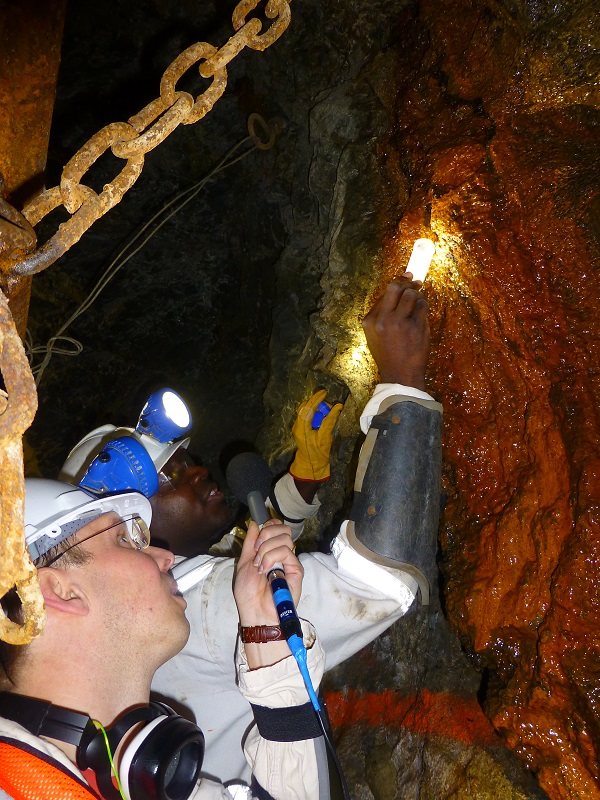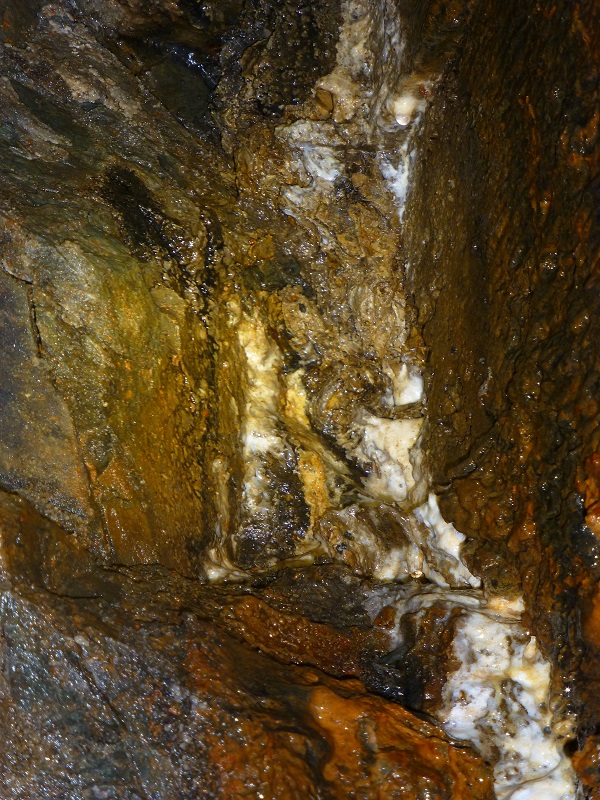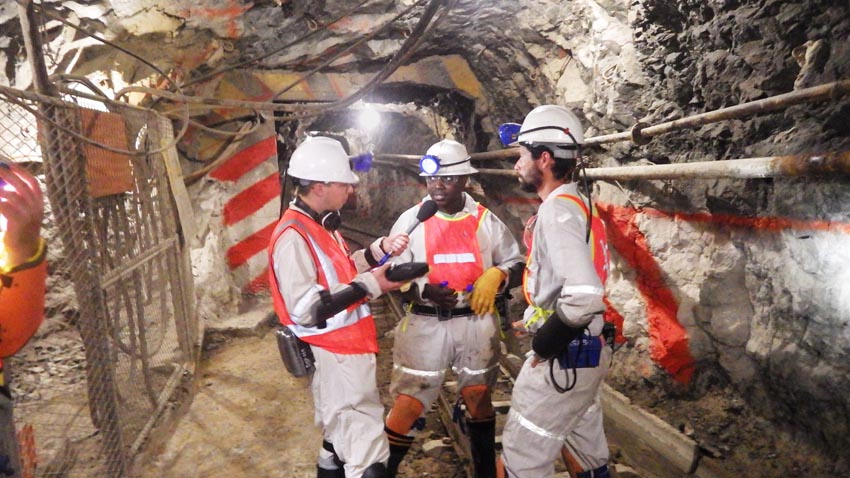Extreme bacteria lurking in gold mines
Interview with
South Africa is home to the world's richest sources of gold and the world's deepest mines that have been dug to access it. But in the course of tunnelling up to 4 kilometres vertically down to recover the gold, miners recently struck scientific gold with the discovery of populations of microorganisms thriving in extreme conditions. The temperatures down there are up to 70 degrees Celsius, and the organisms survive by breaking down minerals and even using the radiation given off by the uranium naturally present in the rock. Chris Smith joined the team collecting samples from seeps kilometres underground...

Kay - My name is Kay Kuloyo. I'm a researcher at the University of the Free State, working to understand the limits of life in extreme environments. We know that we can find extreme life in places like deep sea vents and water sources. And also, with that notion that there could be life on other planets, and where are the places that we feel we can have such conditions, it's in the centre of the Earth. Mining activities have provided that kind of opportunity for us to be able to access these places.
Chris - What's been discovered already?
Kay - In 2010, there was a paper that was published about a worm found in fissure water one of the mines. This is one of the biggest discoveries to date because before that, we only found bacteria. So, that gave an indication that there could be different levels of life in extreme environments.
Chris - When we say extreme environments, where were these organisms found growing?
Kay - We're talking about in the deep mines where there's very little nutrients and the temperatures can go as high as 70 degrees Celsius.
Chris - So, to find complicated life growing at those extreme temperatures and very nutrient-poor environments, it says there's something pretty special about those sorts of organisms.
Kay - Yes. It means that these organisms have genes that can help them make the kind of food they need. In the absence of sunlight and other sources, they can actually use the chemicals and the minerals to make their own food. And so, they have these conditions.
Chris - How did they get here?
Kay - Well, the theory is that over millions of years ago, as the water gradually seeps down, these microorganisms came down with the water and they became trapped here. Over time, they have been able to adapt to the conditions here.
Chris - How do you know that's what happened and that for instance they didn't just arrive with the last rainstorm?
Kay - Okay, well we do isotope analysis to determine the age of the water.
Chris - And what does that tell you?
Kay - That tells us that some of the water samples that we've taken here are millions of years ago and sometimes even up to billions of years old.
Chris - So, if the water is that old, the organisms must've been in it for at least that long.
Kay - Yes.
Chris - You've come down here today. The idea is to actually collect some samples. How are you doing that?
Kay - We have sterile Falcon tubes we always carry which are for grab samples. If we find a seepage in the rocks, we can take some of the water samples and then we  culture in the lab and see what's in there.
culture in the lab and see what's in there.
Chris - Because there's some water dripping down over here. Is this of interest?
Kay - Well, we see water are coming out of the rocks like this. This is probably old water that's seeping out. What you see on the surface of the rocks like the brown colour and the black colour, we think that's a microorganisms that are growing on the rock and also using the nutrients from the water to survive. So over time, they form a film on the rock of different colours - black or brown or white or pink, depending on the kind of nutrients that they're using.
Chris - Do you have a lot of contamination from microorganisms brought here by us?
Kay - Yes, because there's a lot of human activity, mining activity around here. Most times, we find microorganisms that have come from human activities even sometimes common microorganisms like E. coli. So, we have to be really careful what we see is originally from the mine and what's on the surface.
Chris - Shall we grab a sample?
Kay - Yes.
Chris - Get across the railway tracks, not falling in the drainage ditch.
Kay - I will open this sterile falcon tube which is about 50 millilitres and I'm going to scrape some of the water sample from the side and trying to scrape some of the brown stuff. Even very little water samples can yield a lot of information about the microorganisms. With my other tube, I'm going to scrape some of the black colour because we think that could be sulphate which is in bacteria. I don't know if you can smell a little bit of hydrogen sulphide.
Chris - It does smell a bit sulphurous, yeah. Why do you think the sulphur is important?
Kay - Because usually, what you find in the gold mines is a lot of pyrites and sulphates as well and you know, that's also associated with gold. So, a lot of times, we find sulphate reducing bacteria.
Chris - So the bacteria are using the sulphates as a food source.
Kay - (crosstalk)
Chris - Yes, because they're obviously not able to rely on energy coming from the sun. They have to get their food chemically.
Kay - From what's around them, yes. You find some of them as a sulphate, some use iron as well and some use perhaps the nitrates. And also, sometimes they use a radiation.
Chris - Radiation.
Kay - Yes, some of the microorganisms can use the radiation as a source of energy.
Chris - What will you now do with that?
Kay - This, we take back to the lab and we do two types of analysis. One is to see if we can actually culture the microorganisms in there because...
Chris - To grow them.
Kay - To grow them, yes.
Chris - You have to recreate a gold mine in your laboratory.
Kay - We recreate the environment here. We're not always successful because these things do not follow the laws of the laboratory. So, we go another step further to understand what they are made of using molecular biology techniques.
Chris - So, as well as trying to grow them, you can then just interrogate them genetically because sometimes they may not grow, but their DNA will be there nonetheless and that means you can find them.
Kay - Exactly. So, we used their DNA profile to reconstruct what's actually in there to understand all the bacteria, all the sorts of life that are in the samples.
Chris - What are the implications of these discovery?
Kay - Well, because of the conditions that we're finding these  microorganisms in, we are able to use some of these microorganisms for bioremediation purposes.
microorganisms in, we are able to use some of these microorganisms for bioremediation purposes.
Chris - Cleaning things up.
Kay - Cleaning things up like acid mine drainage and things like that. So also, we use them for green technologies, taking away more chemicals and using biological agents. Also for instance, microorganisms that we find in high temperature areas, it means they are able to produce enzymes that are thermostable.
Chris - As the vice president of the company I just pointed out, can you not discover a strain of organism that will eat gold and then pour it out in the right place to make their job a lot easier?
Kay - Well, that's some of the research that we're doing. We have microorganisms that can bioaccumulate the gold and then we can extract the gold from the microorganisms. So, as one of them pointed out that in places where they cannot really reach or it's dangerous, it's possible for us to use microorganisms, that's the next level that we're looking at. We have some bench scale applications of this where we've seen it happen. Not just gold, but copper and some other minerals that can lead to bigger levels and really showing that it can work as what we're looking at now.
(Our thanks to Sibanye Gold's James Wellsted and his colleagues for making this visit possible.)










Comments
Add a comment